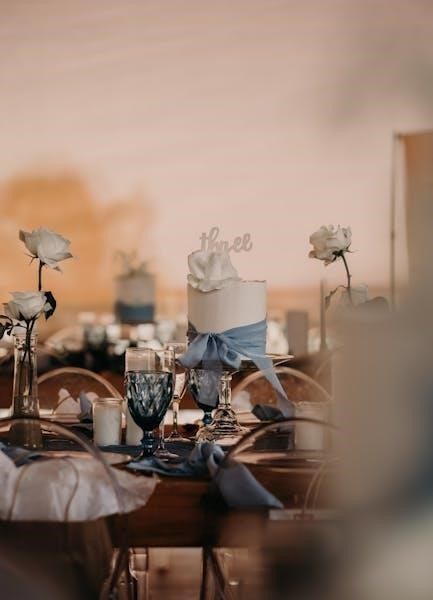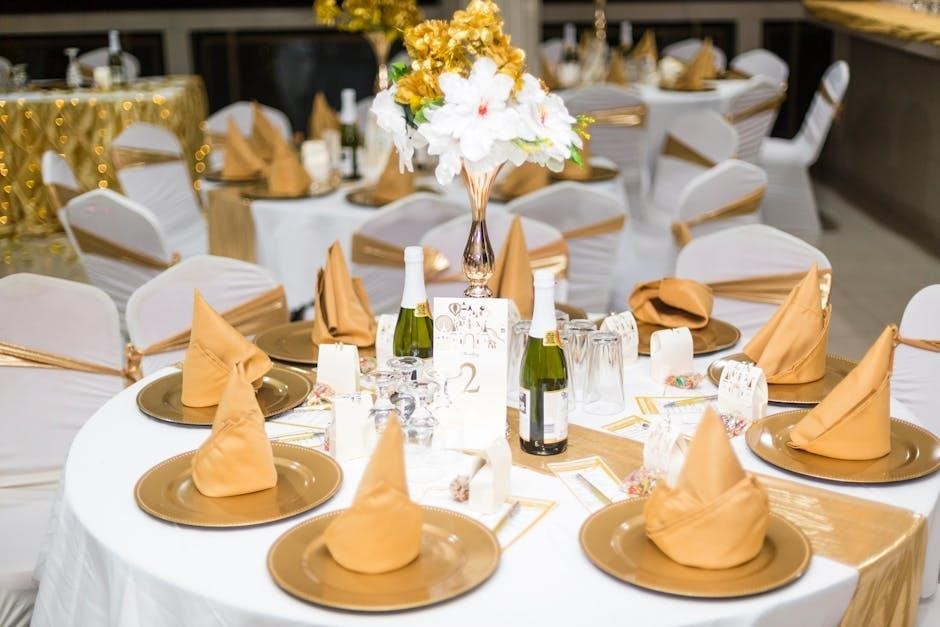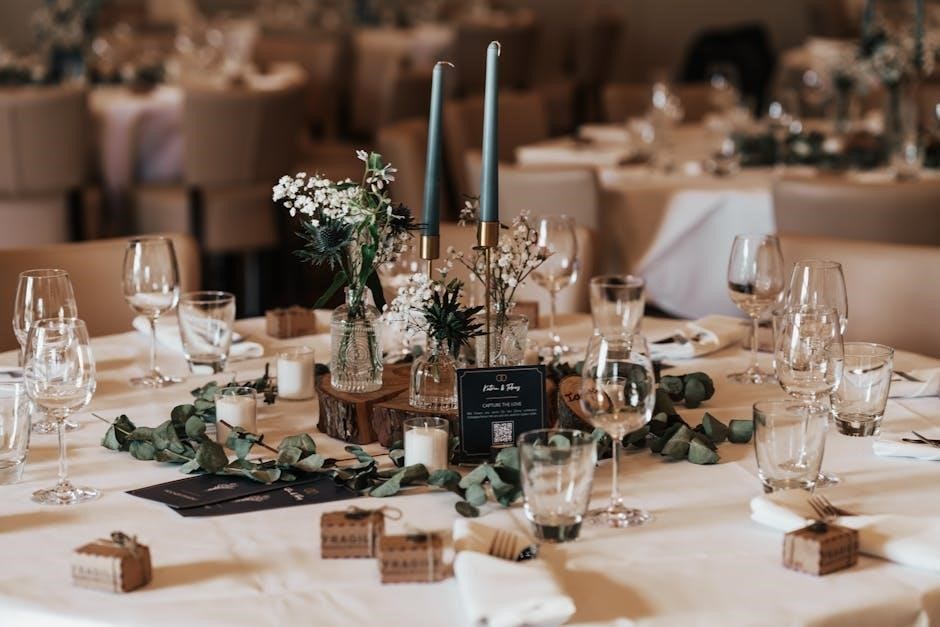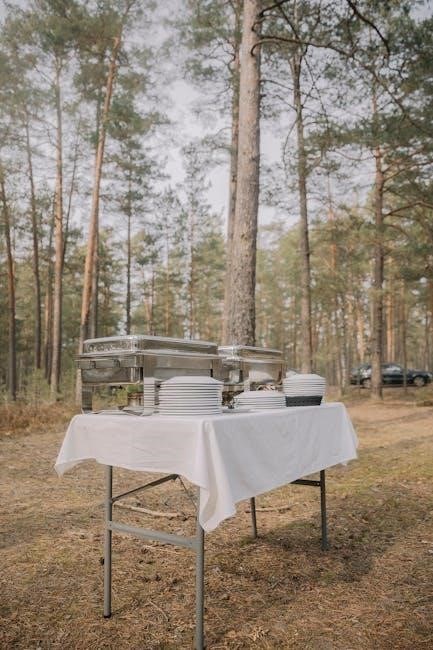
extendable dining table plans pdf
An extendable dining table offers flexibility and space-saving solutions, perfect for accommodating varying numbers of guests․ Plans often include materials like solid wood or metal, detailing hardware needs such as hinges, slides, and alignment pins․ DIY-friendly designs emphasize durability and aesthetic appeal, with options for butterfly leaves or drop-leaf mechanisms․ These plans cater to different skill levels, ensuring a customizable and functional dining solution for any home;
Understanding the Basics of Extendable Dining Tables
An extendable dining table is designed to adapt to different seating needs, offering flexibility for small or large gatherings․ These tables typically feature mechanisms like butterfly leaves, slide-out extensions, or drop-leaf designs, allowing the tabletop to expand or contract․ The base and legs are constructed to support the added weight when extended, ensuring stability․ Extendable tables are ideal for spaces with limited room, as they can be compact when not in use․ They come in various styles, from modern to traditional, and can be made from materials like wood, metal, or a combination․ Understanding how these mechanisms work and how they integrate into the design is key to appreciating their functionality and versatility․
Why Choose an Extendable Dining Table?
An extendable dining table is a practical and versatile solution for modern living, offering the flexibility to accommodate both small gatherings and large events․ Its ability to expand or contract makes it ideal for homes with limited space, as it can adapt to different needs without compromising on style․ Unlike fixed-size tables, extendable designs provide the convenience of hosting more guests when needed, while maintaining a compact footprint for everyday use․ This feature is especially beneficial for families, entertaining enthusiasts, or those living in urban areas․ By choosing an extendable dining table, you gain a space-saving, functional, and stylish centerpiece for your home that enhances both comfort and hospitality․

Design Considerations for Extendable Dining Tables

Design considerations focus on balancing functionality and aesthetics, ensuring smooth operation of extension mechanisms while maintaining structural integrity․ Choose materials and styles that align with your space and needs․
Space-Saving Features and Flexibility
Extendable dining tables are designed to maximize space efficiency while offering versatility for varying needs․ Features like butterfly leaves and self-storing extensions allow the table to expand seamlessly, accommodating additional guests without compromising on style․ Slide-out mechanisms and drop-leaf designs provide further flexibility, enabling the table to fit into smaller spaces when not in use․ These space-saving solutions are ideal for modern homes, where multi-functional furniture is essential․ Minimalistic leg designs ensure ample legroom, even when the table is extended․ Customizable lengths and widths further enhance adaptability, making extendable dining tables a practical choice for both everyday use and special occasions․
Modern vs․ Traditional Designs
Extendable dining tables come in a wide range of styles, catering to both modern and traditional aesthetics․ Modern designs often feature sleek lines, minimalist profiles, and innovative materials like metal or glass, emphasizing functionality and contemporary appeal․ Traditional designs, on the other hand, focus on classic craftsmanship, incorporating ornate details, carved wood, and timeless shapes․ Both styles offer practical solutions for space-saving and flexibility, but the choice depends on personal preference and home decor․ Whether opting for a futuristic look or a classic vibe, extendable dining tables seamlessly blend practicality with elegance, ensuring a perfect fit for any interior design․
Materials and Tools Required
Building an extendable dining table requires high-quality wood, metal hardware, and essential tools like table saws, drills, and routers․ Materials include solid wood planks, hinges, slides, and alignment pins for smooth operation․
Wood Selection and Hardware Needs
Selecting the right wood is crucial for durability and aesthetics․ Oak, maple, and pine are popular choices for their strength and appeal․ Hardware such as hinges, slides, and alignment pins ensures smooth table extension․ A biscuit joiner and dovetail bits are recommended for precise joints․ The table top often uses 3/4-inch-thick planks, while legs may require thicker stock for stability․ Proper hardware selection prevents wobbling and ensures the table expands effortlessly․ Always follow the cut list from your PDF plans to ensure accurate material preparation․ High-quality fasteners and finishes protect the wood and enhance the table’s longevity․ Plan carefully to avoid material waste and ensure a professional finish․
Essential Tools for Construction
Building an extendable dining table requires a well-equipped workshop․ A table saw is essential for cutting large wood planks accurately․ A drill and router are necessary for creating joints and decorative edges․ A power sander ensures a smooth finish, while a drill press adds precision for drilling straight holes․ Optional tools include a biscuit joiner for strong, invisible joints and a dovetail bit for detailed drawer construction․ Additional bits, like straight and decorative edge bits, enhance customization․ Safety gear, such as goggles and a dust mask, is crucial․ Refer to your PDF plans for specific tool recommendations, ensuring all hardware and woodcuts align perfectly for a professional result․

Popular Mechanisms for Extending Dining Tables
Popular mechanisms include butterfly leaves, slide-out extensions, and drop-leaf designs․ Butterfly leaves are self-storing and ideal for seamless expansion․ Slide-out and drop-leaf options offer versatile space-saving solutions․

Butterfly Leaf and Self-Storing Leaves
The butterfly leaf mechanism is a popular choice for extendable dining tables, offering a sleek and efficient way to expand the table surface․ This system features two leaves that fold outward from the center, creating a larger surface area without the need for additional storage space․ Self-storing leaves are designed to tuck neatly underneath the table when not in use, maintaining a clean and streamlined appearance․ This mechanism is ideal for those who value convenience and aesthetics, as it eliminates the need for separate storage while providing ample space for entertaining․ The design ensures smooth operation and durability․
Slide-Out and Drop-Leaf Mechanisms
Slide-out and drop-leaf mechanisms provide excellent functionality for extendable dining tables, offering practical solutions for space optimization․ The slide-out mechanism involves extending the table by sliding additional panels or leaves from beneath the surface, often guided by rails or gliders․ This design allows for seamless expansion, doubling the table’s capacity when needed․ Drop-leaf mechanisms, on the other hand, feature hinged sections that fold down from the table’s sides, providing extra seating without requiring additional storage․ Both mechanisms are favored for their simplicity and effectiveness, making them ideal for compact dining areas․ These systems ensure versatility, adaptability, and ease of use, catering to diverse household needs efficiently․
DIY Extendable Dining Table Plans
DIY extendable dining table plans offer step-by-step guides for crafting durable, custom tables․ They include cut lists, hardware requirements, and tool recommendations for a seamless project․
Step-by-Step Instructions for Beginners
Start by planning your table dimensions and gathering materials, including wood planks, legs, and hardware․ Cut the table top and leaves according to the PDF plans․ Assemble the frame using rails and posts, ensuring stability․ Attach the butterfly or self-storing leaves with hinges, aligning them properly․ Sand all surfaces for a smooth finish and apply your desired stain or paint․ Once dry, assemble and test the extension mechanism to ensure smooth operation․ Follow safety guidelines and use tools like a table saw, drill, and sander carefully․ This DIY project allows you to create a functional, stylish extendable dining table tailored to your space and needs․
Customizing Your Table Design
Personalize your extendable dining table to match your home decor and preferences․ Choose from various wood types, such as oak, maple, or pine, for a natural look․ Opt for a modern or traditional design, with options like rounded or tapered legs․ Add decorative elements, such as carved details or unique finishes, to make the table stand out․ Incorporate storage solutions, like benches or drawers, for a practical touch․ Select hardware that complements the table’s style, such as sleek metal or rustic hinges․ Consider adding self-storing leaves or a butterfly mechanism for seamless extension․ Use paint or stain to achieve your desired color and finish․ Customizing ensures your table is both functional and aesthetically pleasing, tailored to your lifestyle and space․

Adding a Bench to Your Extendable Dining Table
A bench complements your extendable dining table, offering additional seating and a cohesive design․ Choose a matching style and material for a seamless look, while storage solutions like under-bench compartments enhance functionality․
Designing a Matching Bench
Designing a bench to match your extendable dining table ensures a cohesive and stylish dining setup․ Use the same wood type and finish as the table for consistency․ Consider the table’s leg style, whether rounded or straight, and replicate it in the bench design․ For added functionality, incorporate storage solutions like under-bench compartments or lift-top storage․ Ensure the bench proportions align with the table’s size for a balanced look․ Add cushions or upholstery for comfort, while maintaining the overall aesthetic․ A well-designed bench enhances both the functionality and visual appeal of your dining area, creating a harmonious and inviting space for family and guests․
Storage Solutions for Benches
Incorporating storage into your bench design enhances functionality while maintaining a sleek appearance․ Consider adding hinged tops or lift-top storage compartments to keep items like linens, utensils, or place settings within easy reach․ For larger benches, built-in shelves or drawers can provide ample space for organizing dining accessories․ Ensure the storage solutions align with the bench’s aesthetic, using materials that match the dining table for a cohesive look․ Practical yet stylish, these storage options maximize space without compromising comfort or design, making your dining area both functional and visually appealing for everyday use or special occasions․

Final Tips for Building Your Extendable Dining Table
When completing your extendable dining table, ensure all components are precisely aligned and securely fastened for smooth operation․ Test the extension mechanism repeatedly to guarantee reliability and even weight distribution․ Sand all surfaces thoroughly and apply a durable finish to protect the wood and enhance its appearance․ Consider adding decorative elements like edge detailing or carved legs for a personalized touch․ Finally, assemble the table in the intended space to confirm fit and functionality, making adjustments as needed․ Regular maintenance, such as tightening hardware and refinishing, will extend the table’s lifespan, ensuring years of reliable service and timeless style․
Related Posts

acls exam version c answers pdf
Get ACLS Exam Version C answers in PDF format. Free study guide, practice questions, and instant download. Prepare smarter, not harder!

explaining adhd to a child pdf
Learn how to explain ADHD to children in a simple, engaging way. Download our free PDF guide to help kids understand and manage their ADHD.

john paul jackson books pdf free download
Access John Paul Jackson’s books for free in PDF. Instantly download his spiritual teachings and revelations.